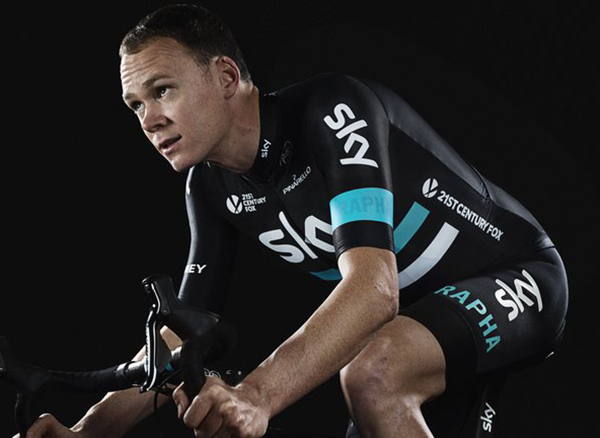Bicycle Racing News and Opinion,
Saturday,
December 12, 2015
Bicycle Racing News and Opinion,
Saturday,
December 12, 2015
Back to news and opinion index page for links to archived stories | Commentary
I have noticed even people who claim everything is predestined, and that we can do nothing to change it, look before they cross the road. - Stephen Hawking
Chris Horner has antibiotic resistant infection
This story was in Business Insider Indonesia:
Chris Horner, one of the most accomplished riders in American cycling, has revealed to Business Insider that he’s been battling a superbug that could force him to end his racing career.
The bug is called Pseudomonas aeruginosa, and Horner said it seriously affects his lungs during competition. The condition “feels like asthma,” he said, but emphasized it isn’t actually asthma.
Pseudomonas infection is caused by strains of bacteria found widely in the environment, according to the Centers for Disease Control and Prevention. The CDC says that while serious infections usually occur in people in the hospital or with weakened immune systems, healthy people can also develop mild illnesses. Pseudomonas infections are generally treated with antibiotics.

Chris Horner racing in the 2014 Tour de France
“I knew there was some kind of bug down there, and they finally found it at the end of October,” Horner said by phone from his home in Oregon this week. “I did eight rounds of antibiotics and just finished my ninth.
“But of course each round has been different, and it’s stronger antibiotics each time,” he added. “Before this last round, they didn’t know what they were trying to kill, so hopefully now that they’ve done the bronchoscopy, they know exactly what they’re trying to kill.
“Every doctor I talk to says, ‘You’re on the right path — you just gotta wait it out,’” Horner said. “So I’m trying to keep the head in a good place, but if the season starts and I got a bug in the lungs, maybe I move on to something else.”
Superbugs — bacteria that are resistant to antibiotics — have been around for decades, but they are getting increasingly harder to treat. One of the chief drivers of the resistant bugs is our zealous over prescription of antibiotics. Doctors prescribe the drugs for ailments that they don’t even treat and farmers put them in animal feed. The problem is global.
“Long term it seems like the body will eventually take care of it, but I won’t be able to race comfortably until it is gone,” he said. “But no risk beyond racing issues for me. We’ll see if the latest round of antibiotics works its magic in the coming weeks,” he added. “I’d love to see how long I could race my bike for.
“I mean, I’m 45 next year. In cycling, most riders are done at by 34, a few go 35, and 36 is old. So when you’re going 44 like I was this year, that’s eight years past the expiration date.”
It was at the 2014 Tour de France that Horner believes he picked up the bug, he said, and it has affected his performance on the bike ever since.
“I’m thinking it was picked up on the cobblestone day [stage 5] when it rained and we were racing across the cobbles,” he said. “But it’s a guess. No one could tell you. It’s like if you get a cold and they’re like, where’d you get it? I can only tell you the period of time it was picked up, July 2014. Then again, maybe I got sick because I was sleeping on the wrong pillow.
“At first it started off with Z-Pak, which works for common colds or something like that,” he said. “It got more intensive, and I ended up with ciprofloxacin, which is basically a super-strong antibiotic that hopefully kills it off, but this is sort of the last three-week dose of ciprofloxacin. We’ll see if it works. Whatever the bug is, it’s really antibiotically distant, so they’ve had an incredibly difficult time trying to kill it.”
Click here for the rest of the story
Team Sky unveils 2016 kit
Here's the team news release:

The countdown is finally over and we're delighted to unveil the new Team Sky kit for the 2016 season.
The racewear has been developed by Rapha to stand out in the peloton and features a bold new design which is the result of months of development and testing. The riders will be wearing cutting-edge fabrics, beautifully crafted to provide speed and comfort.
The kit has been given the thumbs up from staff and riders alike, with Performance Manager Rod Ellingworth confirming: "The feedback we've got from the riders, especially our new signings who have already tried it, is that it's the best performing kit in the peloton. They all say how smart they feel in it too. Working closely with Rapha ensures that we have the best fitting, fastest, and comfortable racewear out there."

Chris Froome in the 2016 Sky kit
The updated graphics were born from our desire to stand out in the pack whilst retaining the elegant black and blue kit we're known for. There was only one thing that needed to stay consistent, the feature that sets us apart from the competition - the famous blue line which still appears on the rear of the jersey.
With a new shade of blue that stands out better against black, our riders will be able to pick each other out more easily during races, as will the fans on the roadsides and those watching on TV. The new blue will also be used on our bikes and equipment.
Ride the lines
For the biggest change, Rapha have added a pair of stripes across the chest of the jersey, a style which echoes their Brevet collection. Distinctive, but understated - a style which breaks from the norm in a peloton of loud jerseys.
Lotto-Soudal adds to its medical staff
This update came from the team:
Lotto Soudal expands its medical department for 2016. Three doctors, three physiotherapists, a mental coach and a nurse are part of the medical structure of Lotto Soudal. New is the introduction of the Cycling Think Tank; lead by chief doctor Servaas Bingé, sports director Mario Aerts and physiotherapist Tim Aerts. Cycling gets more and more scientific; because of that, Lotto Soudal expands its medical structure.
Servaas Bingé, chief doctor Lotto Soudal: “The medical staff of Lotto Soudal is also present during races and training camps. A total of eight persons takes care of the riders; they get optimal care and medical assistance. The medical team includes three doctors: Servaas Bingé, Steven Bex and Maarten Meirhaeghe (new); three physiotherapists: Tim Aerts, Geert Beirnaert and Bart Govaerts (both new); a mental coach: Nathan Kahan and a nurse: Jochen Fordeyn (new). Behind this operational structure, we have the ‘Cycling Think Tank’ (CTT, LTS); a breeding ground of knowledge and scientific innovation that supports the medical staff of Lotto Soudal. Supported by several scientists (Professor Romain Meeuwsen VUB, Asker Jeukendrup (international nutritionist,...), and doctors (Olivier Ghekiere (Radiologist Jessa Ziekenhuis Hasselt), Toon Claes (AZ Sint Elisabeth Herentals) and doctor Coeman (Az Sint-Vincentius Deinze)), the Cycling Think Tank wants to help the team to empower its scientific way of thinking.”
According to the CTT, current cycling needs to be supported on five important terrains: Body – Mind – Training – Nutrition – Materials, Tactics & Technique. By investing in these different areas and partnerships, CTT wants to help the riders develop. One of the partners is SANAS; a supplement partner of the team who makes custom-made sports nutrition. Also Energy Lab is one of the partners that organizes the testing, training programmes and training rides.
Servaas Bingé: “We started a couple of weeks ago by reading existing scientific literature. There is already a lot of material that can be found, so we don’t need to invent new things. It’s an art to use the available scientific knowledge and put it into useful protocols and guidelines. Riders don’t need figures and graphics; they want to know what they can eat and which food is healthy. We want to keep it as simple as possible; not because the riders are stupid, because we see more and more scientific books in their rooms. This creates a nice dynamic.”
“The first focus is to optimize their nutrition. We don’t just eat whatever we like, what lays on the plate is based on several things: type of rider, kind of training, period in the season, taste,… By optimizing the nutrition and adjusting it to the training programme, we can still make some progress. Next important thing is the fluid intake. During this training camp, we’re calculating the fluid intake for every rider individually. Before and after every training, we test them on multiple parameters and collect the figures so we can give the riders a perfect insight in their needs.”
The medical structure of Lotto Soudal expands in 2016 and will without any doubt lead to a positive contribution on the performances and overall development of the riders.
Long-time bicycle industry leader Bill Austin dies
This was in Bicycle Retailer:
OLDSMAR, Fla. (BRAIN) — Bill Austin, whose role in the bicycle industry spanned more than 30 years, died Sunday after a long illness. He was 78.
Many in the industry perhaps best remember Austin for his keen focus on developing reliable industry statistics during his many years serving on the board of the Bicycle Products Suppliers Association.
His career spanned executive leadership positions at Schwinn, Giant USA and Raleigh Bicycles. “He was passionate for the industry and the dealer,” recalled Steve Meineke, former president and CEO at Raleigh USA.
“That passion was translated in many forms as both an industry advocate and how he ran the industry’s statistical committee. He grabbed that (statistics) and embraced it,” Meineke said. “It was during an era (the 1990s) when the industry really needed it. Still, he always kept his eye on the dealer,” he added.
Austin joined the industry after leaving General Electric to join Schwinn Bicycles as an executive vice president reporting to Ed Schwinn. He joined the company in 1979.
“Bill was unique. He came to Schwinn at a critical time and his expertise was really needed,” recalled Jay Townley, a Schwinn executive who reported to Austin at the time. “I am always saddened when I learn that someone in the industry has passed away,” he added.
Skip Hess, who first joined Giant USA in 1987 as its product manager, said Austin brought a “lot of business knowledge” to the industry. “We didn’t really want to talk about business. It was always product- and sales-centric. Bill always loved the numbers. He was one of those guys who could always find that bad number in a stack of reports and he was always right,” Hess said.
Pat Cunnane, president and CEO of Advanced Sports International, said he first worked with Austin in 1988. Austin had just been named president of Giant USA and he was putting a team together in New Jersey. “I had talked with him after Interbike and he told me that he had been sick. Even though I had some warning, I couldn’t believe it. I’m still sort of in shock,” Cunnane said.
Here's the complete story in Bicycle Retailer
Back to news and opinion index page for links to archived stories | Commentary









